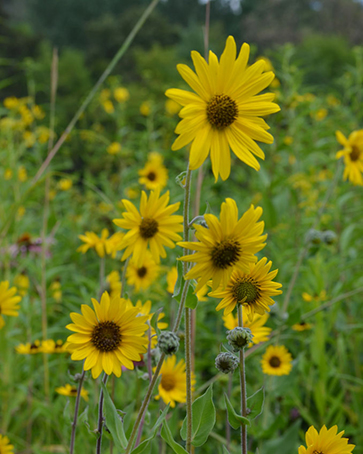Downy Sunflower
 Helianthus mollis
Helianthus mollis
This plant is distinguished by its fine, soft, downy hairs that cover its stems and leaves, giving it a characteristic bluish-gray-green hue.
Introduction
The Downy Sunflower is a classic perennial sunflower. This classic composite sunflower blooms for several weeks from July to September. It thrives in poor, dry soils, such as those with gravel, rock, or clay, where it forms dense stands. However, in nutrient-rich, medium soils, it grows taller. Remarkably, it requires no watering or fertilization to flourish.
The plant’s root system likely produces allelopathic chemicals that inhibit the growth of neighboring plants. As a result, Downy Sunflower is considered aggressive, spreading underground via rhizomes. For better control, removing seed heads before they ripen is a more effective alternative to managing unwanted seedlings.
The Downy Sunflower can be found growing in the prairie at Gabis Arboretum.
Life Cycle
Perennial
Sun Exposure
Full, Partial
Soil Moisture
Medium, Medium-Dry
Height
5 feet
Bloom Time
August, September
Bloom Color
Yellow
About the Plant
Bees are the primary visitors to its flowers, drawn by nectar and pollen. These include bumblebees, Miner bees, large Leaf-Cutting bees, Cuckoo bees, Green Metallic bees and Halictid bees. Occasionally, bee flies and butterflies also visit. The foliage serves as a food source for the caterpillars of the Silvery Checkerspot and Gorgone Checkerspot butterflies. Additionally, various moth species and other insects feed on different parts of the plant.
The seeds are a favorite among upland game birds and granivorous songbirds, particularly the American Goldfinch. Notably, the Sunflower Head-clipping Weevil is highly attracted to the Downy Sunflower. The adult weevil causes flower heads to droop and fall, while its larvae consume the flower heads.